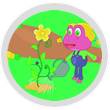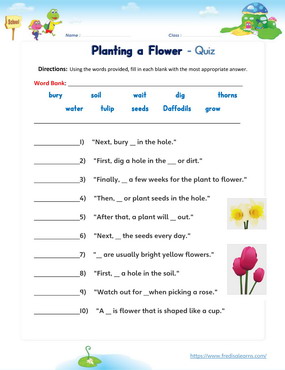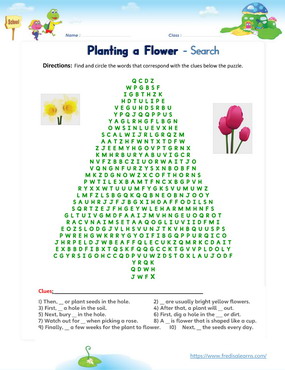Unit 2: Planting a Flower
Objectives:
- Learn to use adverbs of sequence to describe a process.
- Teach EFL/ESL learners the names of flowers and vocabulary related to planting and growing crops.
- To teach kids English lesson verb noun collocations relating to growing crops.
Main Lesson Materials & Study Steps
1st –This cartoon animated video features a short dialogue, followed by vocabulary and sentence breakdown. It is essential for introducing the words, phrases, grammar, spelling and sentences of the lesson in context. Watch repeatedly to master the content. The video plays on any device.
2nd – Then the student plays this fun game after watching the video, to practice the contents of the lesson. The game reviews key vocabulary, grammar and sentences from the lessons. This game can be played on any device.
3rd – Finally the learner takes this test of the unit. The score of this test is captured in the LMS and gives educators an idea of how well their learner is doing. The test opens on any device – mobile & PC.
Worksheets for the Unit
The worksheets below are useful for offline and classroom activities. These printable exercises directly correlate with the above lesson 'Planting a Flower'. Every worksheet comes with an answer sheet on the second page for educators.
Already a Member?
Not a member yet?
Lesson Story:
Freddie and Lisa are out walking when they come across roses. Lisa rushes to pick a flower but does not realize that rose plants have thorns. Freddie tries to caution her but it is too late. She gets pricked by a thorn. Freddie teaches her how to grow flowers.
Vocabulary:
Names of flowers
| roses | daffodils | tulips |
Other words
| thorns |
| water |
| soil (dirt) |
| plant |
| hole |
| seed |
| grow out |
| wait |
| sun |
Verb/Noun Collocations
| plant | seeds |
| pick | roses |
| water | plants |
| dig | a hole |
| bury | seeds in the soil |
Key Sentences:
Adverbs of sequence – How to plant flowers
- First, dig a hole in the soil.
- Then plant the seeds.
- Next, you water the seeds every day.
- After that, a plant will grow out.
- Finally, wait a few weeks for flowers to come out.
Dialogue Script
Lisa: It’s such a pretty walk outside, Freddie.
Freddie: Yes it is.
Lisa: Look! There’s a flower!
Freddie: It looks like a rose. Lisa, stop!
Lisa: OW!
Freddie: Roses have thorns, Lisa. You can’t pick them.
Lisa: Do all flowers have thorns?
Freddie: No, Lisa. Look, this is another flower. It doesn’t have thorns.
Lisa: Freddie, will you show me how to plant a flower?
Freddie: Sure, Lisa! Let’s go home.
Lisa: Why are you digging in the soil?
Freddie: The first thing you have to do is dig a hole in the soil, or the dirt.
Lisa: Then what will you do?
Freddie: Then, you plant the seed. The seed is what the flower grows out of.
Lisa: After you plant the seed, you have to water the plants.
Freddie: With water, they are able to grow. Sun also helps them grow.
Lisa: How long will it take them to grow?
Freddie: It will take a few weeks.
Lisa: Do we just wait?
Freddie: No. We have to water the seeds every day.
This lesson is part of the Level 5 English course.
In this English lesson, young learners will discover the joy of planting flowers while learning new vocabulary and sentence structures. Students will learn adverbs of sequence to describe the step-by-step process of planting a flower, such as "first," "next," and "finally." They will also be introduced to essential vocabulary related to planting and growing crops, such as soil, seed, water, and sunlight.
Additionally, students will learn the names of different flowers and how to use verb-noun collocations when discussing the process of growing them. They will learn about germination, growth, and the life cycle of plants. By the end of the lesson, students will have a better understanding of how to describe the process of planting a flower and will have a new appreciation for the natural world.
This lesson not only helps EFL/ESL learners improve their English language skills but also encourages a love for nature and the environment. It is a great way to engage students in hands-on activities while practicing their language skills.














